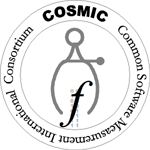COSMIC Software Size Measurement
 COSMIC is an internationally recognised standard ISO/IEC 19761:2003 for sizing the functional requirements of software. It was developed in the late 1990s by an International Standards Organisation (ISO) Workgroup comprised of international software metrics specialists.
COSMIC is an internationally recognised standard ISO/IEC 19761:2003 for sizing the functional requirements of software. It was developed in the late 1990s by an International Standards Organisation (ISO) Workgroup comprised of international software metrics specialists.
COSMIC was expressly designed to improve the accuracy of measuring modern software systems, and address some of the short-comings of earlier functional size measurement methods. It can be used for business/MIS, Real-Time and Embedded Systems.
Functional Size Measurement derives software size from the business functionality delivered by the software. It is a management metric used to obtain reliable and comparable measures of software productivity, velocity and value-for-money.
COSMIC is unquestionably the recommended method of measuring functional output. It is an intuitive method that can be easily learned by business users and software professionals alike, giving business and IT a common language for scoping, sizing and costing software projects. It can be used equally well with agile or more traditional development methods.
COSMIC measures the output of the software development process
Unlike input measures such as Story Points, or lines of code, COSMIC size units encompass both cost (development effort consumed) and benefit (requirements fulfilled) of software development.
COSMIC unlocks the door to reliably measuring productivity, velocity, quality, and value-for-money. An objective measure of software size derived from requirements gives a reliable estimate of software project costs, duration and effort consumption which is focused on delivering what the customer of the software development team needs, when he needs it, at a fair price.
PRODUCTIVITY: The capacity to measure the amount of output produced for input provided gives an objective productivity figure.
VELOCITY: Measured against time – Eg cfp delivered per elapsed month – COSMIC provides an objective and comparable measure of velocity.
QUALITY: The number of defects detected over total size of delivery – ie no of defects delivered over no of cfp delivered – gives a measure of quality.
EFFECTIVENESS: By comparing costs, effort and time expended per function point delivered, we can also demonstrate the huge waste generated by ineffective software processes compared to the standards of measurable efficiency shown by effective, Right-shifted organisations.
VALUE: COSMIC measures the component of value for which the software developer is solely responsible. Ensuring the functionality delivered is aligned to business need is the joint responsibility of the business user and the development team and outside the scope of functional size measurement.
ESTIMATING WITH COSMIC
COSMIC determines software size by counting data movements. This measure can be derived from documented requirements, which means that an early and accurate size estimate can be produced before any coding begins.
Once the size of the output of the software process – ie the user requirements – has been determined, it can be compared to historic data to produce an accurate estimate of development costs. A comparison with benchmark data will produce an acceptable level of accuracy, but for best results actual productivity figures should be used to calibrate the productivity of each development environment.
If development productivity figures are known, the cost of developing new software can be estimated early enough to make direct comparisons between suppliers, or compare the cost of new development or enhancement of existing systems to the cost of buying a software package – or simply using a non-technical solution.
COSMIC sizing is independent of technology or development methods, so it gives an objective basis for a cost-benefit decision.
COSMIC FOR AGILE
Unlike other functional size methods, where subjective judgements about transactions and boundaries have to be made, the basic functional component of a COSMIC size unit is a single data movement: Entry, eXit, Read, or Write depending on direction of movement ordered.
1 Data Movement i.e. the movement (Entry, eXit, Read or Write) of one Data Group
= 1 COSMIC Function Point
This characteristic makes COSMIC compatible with agile methods, where requirements are evolved incrementally. If requirements are sufficiently well understood for development to begin, they can be measured using COSMIC points. (Conversely, if requirements cannot be measured using COSMIC points, it is questionable whether development work should commence until there is a more disciplined understanding of the desired outcome. Doing the wrong thing in an agile way is not efficient use of resources!)
User Story Template mapped to COSMIC
As a… [ functional user ]
I want to… [ a) detect an event involving one or more OOI & notify the system using one or more entries, or b) make an entry to query some information to be output ]
[ With some frequency and/or set of quality characteristics ]
So that … [ one or more eXits are output and/or data is stored ].
Note: The outcome of the User Story should be of value to the user. User Stories may be combined into ‘epics’ and/or ‘themes’.
Note: calibrate the workhours (wh) per CFP for the local conditions
Size of User Story aka Functional Process
Minimum = 2 (1 Entry and either 1 Write or 1 eXit)
Maximum = no theoretical upper limit
Typical Range = ≥ 5 and ≤ 25 CFP
One data movement = one COSMIC Function Point (CFP)
Click to download FSM Methods Compared
Download paper by Grant Rule comparing the four most commonly used functional size methods: COSMIC, IFPUG, Mk2 and NESMA.
